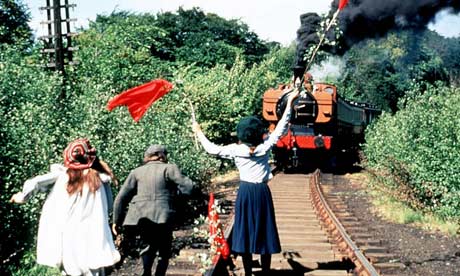
When people talk about "classics" in the book world they tend to be referring to books that have been around for many decades, that have had an impact on many generations of readers and can be read with the same excitement and interest today as they were when they were written.
To me, classics are books that I have been told to read by all-knowing English teachers and that have yellowing pages and a musty smell when you open them. They can be from another time - a time of different values, different ways of talking and behaving in society. Sometimes, because of the way language has changed, they can be harder to understand and take longer to read than a modern novel. But even though they are different, they also show how people stay the same. Bobbie, Peter and Phyllis in The Railway Children miss their dad in exactly the same way that Harry misses his parents in the Harry Potter books. Classics have stood the test of time and convey as much to readers in 2012 as they did in 1912.
But what makes a book classic for you? Is it a book you've been told to read in school? One that you have re-read again and again and still love? Maybe it's a book that your parents read to you and your grandparents read to them, or novels that have been made into films, such as Peter Pan or The Secret Garden. Or it could be that they are books that you want to avoid because they the language is more complicated and the characters seem to speak and behave in a way so different from today.
Vintage Classics are releasing a series of books in August called Vintage Children's Classics, aimed at children aged 8 to 12. The collection will have many books that are conventionally described as classics, for example Anna Sewell's Black Beauty, Lewis Carroll's Alice's Adventures in Wonderland and Rudyard Kipling's The Jungle Book. Alongside these are books that you might be surprised to find on a list of classics.
The Boy in the Striped Pyjamas by John Boyne, which was published in 2006, makes it onto the list, as well as Mark Haddon's 2003 novel, The Curious Incident of The Dog In the Night-time. These books have been hugely popular, and are undeniably thought-provoking and well-written novels. But are they classics already?
Maybe it's time for newer books to be called classics. After all, they could have more impact by being more relevant to today's lives than books written a long time ago. Or should we leave the term to the books we know are still read and enjoyed years after they were first written?
The full list of books Vintage Classics will be publishing is:
Swallows and Amazons by Arthur Ransome
Swallowdale by Arthur Ransome
The Curious Incident of The Dog in the Night-time by Mark Haddon
Emil and the Detectives by Erich Kastner
The Silver Sword by Ian Serraillier
The Boy in the Striped Pyjamas by John Boyne
The Wolves of Willoughby Chase by Joan Aiken
I Capture the Castle by Dodie Smith
Alice's Adventures in Wonderland by Lewis Carroll
Black Beauty by Anna Sewell
The Wind in the Willows by Kenneth Grahame
The Secret Garden by Frances Hodgson Burnett
Little Women by Louisa May Alcott
The Adventures of Huckleberry Finn by Mark Twain
Five Children and It by E Nesbit
The Railway Children by E Nesbit
The Jungle Book by Rudyard Kipling
Treasure Island by RL Stevenson
Peter Pan by JM Barrie
What Katy Did by Susan Coolidge
Would these books be on your classics list? If not, what would? Email and tell us at childrens.books@theguardian.com and we'll print your comments below.

